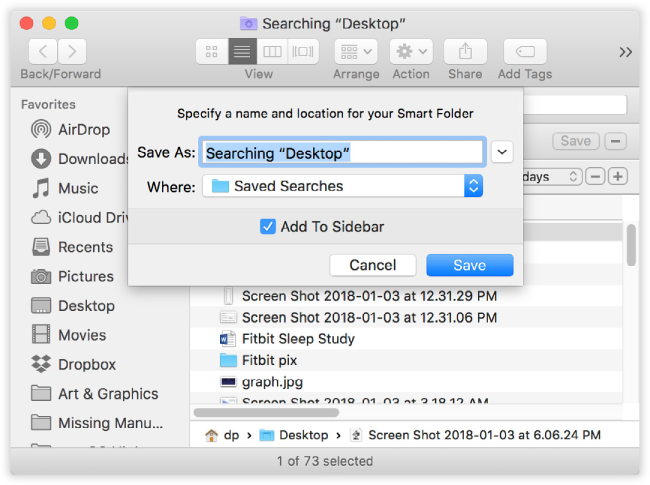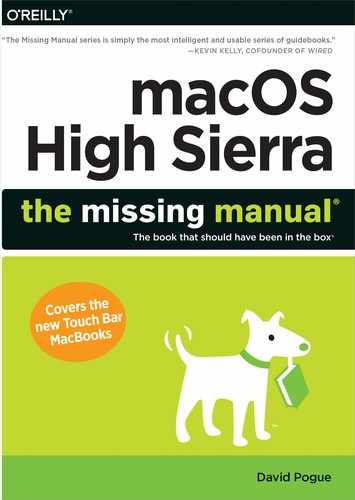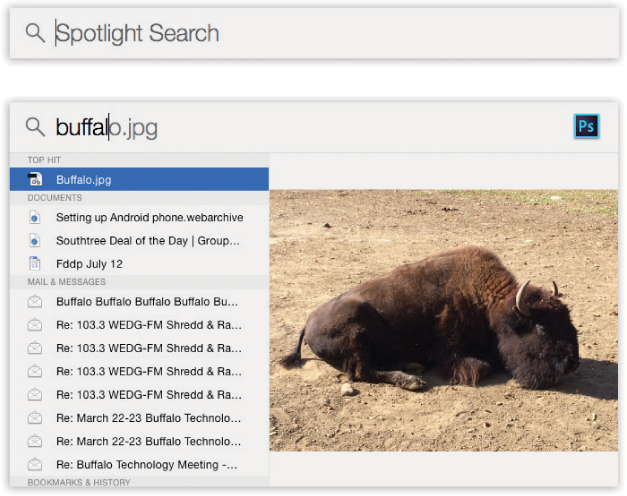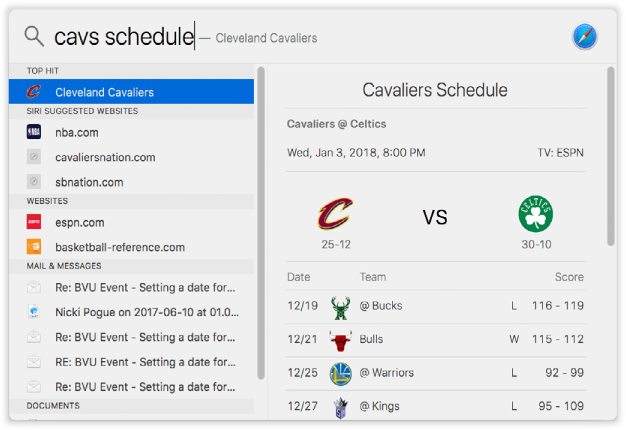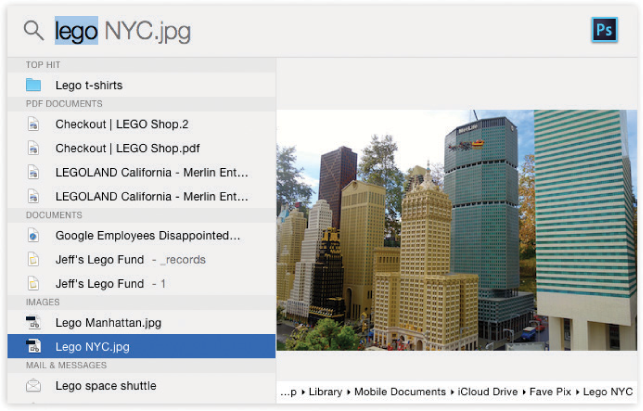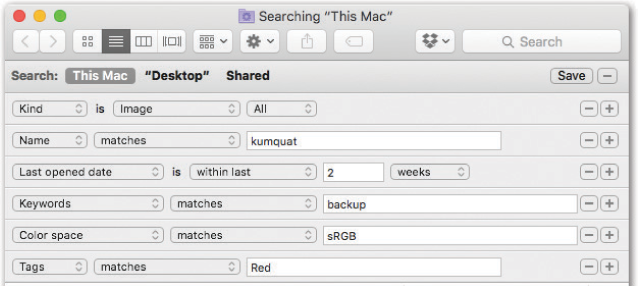Chapter 4. Spotlight
Every computer offers a way to find files. But Spotlight, a star feature of macOS, shows matches for your search word beyond your Mac; it can fetch results from the web, from Apple’s app and music stores, in the Maps app, from movie theaters, and so on. As a bonus, it’s also the world’s most flexible calculator. It can not only do math, but it can also convert things: kilometers to miles, Celsius to Fahrenheit, euros to dollars, and so on.
And it can pull down more information types from the Internet, like sports scores (and schedules and rosters and player stats), Twitter handles (and hashtags), weather, stock quotes, and lists of Vimeo and YouTube videos.
Finally, you can now use “natural language” searches. That is, you can type out plain-English queries that describe what you’re looking for, like “files I worked on in January,” “slides from 2017 containing WidgeTech,” or “images from last year.”
The Searching Window
As you may have noticed, the Spotlight window doesn’t list every match on your hard drive. Unless you own one of those extremely rare 60-inch Apple Skyscraper Displays, there just isn’t room.
Instead, Spotlight uses some fancy behind-the-scenes analysis to display the most likely matches for what you typed. But at the bottom of the results list, you usually see that there are other matches; it says “Show all in Finder,” meaning that there are other candidates.
There is, however, a second, more powerful way into the Spotlight labyrinth. And that’s to use the Searching window, shown in Figure 4-6.

Figure 4-6. When you type your search term, macOS presents a pop-up menu of suggestions. For example, when you type excel, it’s asking: “Would you like me to limit the search to Excel spreadsheets?” If you ignore the suggestions, the window shows you all matches—including files with the word “excel” inside them.
You can open the Searching window in either of two ways.
From Spotlight
If the Spotlight results list—its Most Likely to Succeed list—doesn’t include what you’re looking for, then click “Show all in Finder” at the bottom. You’ve just opened the Searching window.
Now you have access to the complete list of matches, neatly listed in what appears to be a standard Finder window.
From the Finder
When you’re in the Finder, you can also open the Searching window directly, without using the Spotlight window as a trigger. Actually, there are three ways to get there:
 -F (for Find, get it?). When you choose File→Find (
-F (for Find, get it?). When you choose File→Find ( -F), you get an empty Searching window, ready to fill in for your search.
-F), you get an empty Searching window, ready to fill in for your search.
Tip
When the Find window opens, what folder does it intend to search?
That’s up to you. Choose Finder→Preferences→Advanced. From the “When performing a search” pop-up menu, you can choose Search This Mac, Search the Current Folder (usually what you want), or Use the Previous Search Scope (that is, either “the whole Mac” or “the current folder,” whichever you set up last time).
Option-
 -space bar. This keystroke opens the same window. But it always comes set to search the currently open window, rather than everything on your Mac, regardless of the setting you made in Preferences (as described in the previous Tip).
-space bar. This keystroke opens the same window. But it always comes set to search the currently open window, rather than everything on your Mac, regardless of the setting you made in Preferences (as described in the previous Tip).Open any desktop window, and type something into the search box at upper right. Presto—the mild-mannered folder window turns into the Searching window, complete with search results.
Tip
You can change the Find keystrokes to just about anything you like. See “Redefining a Keystroke”.
The Basic Search
When the Searching window opens, you can start typing whatever you’re looking for into the search box at the top.
As you type, the window fills with a list of the files and folders whose names contain what you typed. It’s just like the Spotlight results, but without the item-count limit (Figure 4-6).
Where to look
The three phrases at the top of the window—This Mac, [Folder Name], and Shared—are buttons. Click one to tell the Mac where to search:
This Mac means your entire computer, including secondary disks attached to it (or installed inside)—minus other people’s files, of course.
“Letters to Congress” (or whatever the current window is) limits the search to whatever window was open. So if you want to search your Pictures folder, open it first and then hit
 -F. You’ll see the “Pictures” button at the top of the window, and you can click it to restrict the search to that folder.
-F. You’ll see the “Pictures” button at the top of the window, and you can click it to restrict the search to that folder.Shared. Click this button to expand the search to your entire network and all the computers on it. (This assumes, of course, that you’ve brought their icons to your screen as described in Chapter 14.)
If the other computers are Macs running Leopard (OS X 10.5) or later, then the Searching window can search their files just the way it does on your own Mac—finding words inside the files, for example. If they’re any other kind of computer, Spotlight can search for files only by name.
Tip
If the object of your quest doesn’t show up, you can adjust the scope of the search with one quick click on another button at the top of the window, like This Mac or Shared. The Mac updates the results list.
The suggestions list
When you search, macOS tries to figure out whether you’re looking for file names or words inside files. The Searching window may show you both in the same results list.
But more important, it offers a suggestions pop-up menu, shown in Figure 4-7. Its purpose is to help you narrow down the results list with one quick click. Whatever you click here is instantly immortalized as a search token, described next.
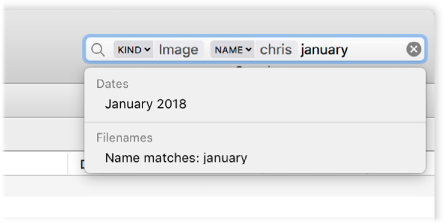
Figure 4-7. Each time you add a criterion by clicking the drop-down list of suggestions, the Mac adds a new token (criterion bubble) to the search box.
Or you can just type what you’re seeking instead of using the bubbles. For example, pictures of chris from january 2018.
You may see any of these headings in the suggestions list:
Filenames. The top option is always Filenames; click it to search by the files’ names only. If you type chris into the box, you want files whose names contain that word.
Sent by. If you type chris, the Mac wants to know if, by chance, you’re looking for email messages and other documents from somebody named Chris (or Christina, or Christopher…).
Kinds. If you type image, the Kinds option here offers you choices like “image” (any kind), “JPEG image,” “Disk image,” or “Portable Network Graphics Image.” If you type document, you get options like “Word document” and “PDF document.” If you search for photo, the menu lets you pinpoint files whose file type contains “photo”—like photo libraries or Adobe Photoshop files. And so on.
Downloaded From. You see this option when what you type is a web address. If you type Macworld into the search box, then “Downloaded From Macworld.com” appears in the results list—a handy way to round up all the files you’ve downloaded from a specific site.
Dates. If you type a month (august or august 2017) or a year into the search box, the suggestions pop-up menu says “Dates: August 2017” (or whatever). Clicking it lets you do a quick roundup of all files you created, modified, last opened, or added during that period.
Tags. Here’s yet another way to use the file tags described in “POWER USERS’ CLINIC Designing Your Own Icons”. When you type a search term that matches one of your tags (for example, green), the suggestions menu includes “Tags: green.”
In each case, the suggestions in this menu reflect only files that actually exist on your Mac. If you search for “green,” but green isn’t one of your Finder tags, then the Tags suggestion doesn’t appear. If you haven’t downloaded anything from Macworld.com, then that option doesn’t appear. And so on.
Once you learn to actually start using these suggestions—once you get the hang of the kinds of things they offer—you can get a lot of mileage out of them.
If, on the other hand, you just find them confusing, no big deal. Tap the Esc key to close the suggestions list and reveal the existing Searching window.
Power Searches with Tokens
The real beauty of the Searching window is that it can hunt down icons via more specific searches than you could using the main Spotlight feature. For example, a feature called tokens lets you combine criteria, so you can find only music files sent to you by Casey. (A token, in Apple’s usage, means “a visual representation of a search criterion.”)
Here, for example, is how you might search for pictures of Chris that were last opened in December.
Note
Before you get too invested in this tokens business—which is not, ahem, especially user-friendly—remember that you can do the same thing using Spotlight’s plain-English searches. You can type, for example, photos of chris from december.
In the Finder, press
 -F.
-F.The Searching window opens.
In the search box, type image.
Sure enough: The window now shows everything on your Mac that is an image or contains the word “image” in its name, or even contains the word “image” within the file. But the list of suggestions (Figure 4-6) wants to know: Which do you really want? Files that are images? Or files with the word “image” in their names?
In the suggestions menu, under Kinds, click Image.
You’ve just pared down the list of results. Now it shows only the files that are photos.
Note, too, that the first token has appeared. Each time you click a refinement criterion, as you did in this step, macOS enshrines it in the search box as a shaded bubble. In this case, it created a token that says “Kind: Image.” (You can see it in Figure 4-7.)
Note
See the tiny ▾ next to the search token’s name? You can click it to see a very short pop-up menu of options: the criterion you selected (like “Kind:” or “Date:”) and another command that says “Everything.” Choosing it undoes the filtering effect of the suggestion, so that this token searches for any attribute of your file (like the words inside it).
Why do you need an “Everything” option here? If you’d wanted to search all attributes on your Mac, you could have just typed directly into the search box without even using the suggestions menu.
Three reasons. First, you might want to expand the scope (from “Kind” to “Everything,” for example) without having to retype the search term. Second, because you might want to make this token part of a smart folder—a saved search—described at the end of this chapter. Finally, you might want to go on to add another search criterion—another search token—that builds on this search for “Everything.”
Now you need to narrow the quest to files containing the word “Chris.”
Continue typing in the search box. This time, type chris.
The suggestions appear again, offering options for file names and, probably, a Sent By list that lists everyone named Chris who’s ever sent you messages or files. What you want is images whose names contain the word “Chris.”
Click Filename.
The list of files is much smaller now. It shows only image files with “Chris” in their names.
For your final stunt, you’ll screen out all but the December images.
Continue typing in the search box. This time, type december.
The suggestions list offers dates like December 2016 and December 2017. You can see the result so far in Figure 4-7.
Click the month you want.
And voilà: The results list shows you only the December photos of Chris.
To delete a token, click it and then press the Delete key, or backspace over it. You can also edit one: Double-click the right side of the token bubble; now you can retype the search term.
Note
This same feature is also in Mail, where it’s even more useful; you have search options like Subject, From, To, and so on.
Power Searching the Old Way
Search tokens are supposed to make multi-criteria searches easier than they used to be. But they’re not as powerful as the Old Way, which is still around.
Using the Old Way of power searching, you can set up a search that finds a document whose name begins with the letters Cro, is over a megabyte in size, was created after 10/1/17 but before the end of the year, was changed within the past week, has the file name suffix .doc, and contains the phrase “attitude adjustment.” (Of course, if you knew that much about a file, you’d probably know where it was, too. But you get the picture.)
In all, the Old Way lets you specify over 125 different search criteria: date modified, file size, the “last opened” date, color label, copyright holder’s name, shutter speed (of a digital photo), tempo (of a music file), and so on. Figure 4-8 illustrates how detailed this kind of search can be.
To set up a complex search like this, use the second row of controls at the top of the window.
And the third, and the fourth, and the fifth. Each time you click one of the ![]() buttons at the right end of the window, a new criterion row appears; use its pop-up menus to specify what date, what file size, and so on.
buttons at the right end of the window, a new criterion row appears; use its pop-up menus to specify what date, what file size, and so on.
Tip
If you press Option, the ![]() button changes into a “
button changes into a “![]() ” button. When you click it, you get subrows of parameters for a single criterion. A pop-up menu lets you choose Any, All, or None, so you can build what are called exclusionary searches.
” button. When you click it, you get subrows of parameters for a single criterion. A pop-up menu lets you choose Any, All, or None, so you can build what are called exclusionary searches.
The idea here is that you can set up a search for documents created between November 1 and 7 or documents created between November 10 and 14. Or files named Complaint that are also either Word or InDesign files.
The mind boggles.
Here’s a rundown of the ways you can restrict your search, according to the options in the first pop-up menu of a row. Note that after you choose from that first pop-up menu (Last Opened, for example), you’re supposed to use the additional pop-up menus to narrow the choice (“within last,” “2,” and “weeks,” for example), as you’ll read in a moment.
Note
It may surprise you that choosing something from the Kind pop-up menu triggers the search instantly. As soon as you choose Applications, for example, the window fills with a list of every program on your hard drive. Want a quick list of every folder on your entire machine? Choose Folders. (Want to see which folders you’ve opened in the past couple of days? Add another row.)
If you also type something into the search box at the very top of the window—before or after you’ve used one of these pop-up menus—the list pares itself down to items that match what you’ve typed.
Kind
When the first pop-up menu says Kind, you can use the second pop-up menu to indicate what kind of file you’re looking for: Applications, Documents, Executables (programs and Dashboard widgets), Folders, Images, Movies, Music, PDF files, Presentations, Text files, or Other.
For example, when you’re trying to free up some space on your drive, you could round up all your movie files, which tend to be huge.
And what if the item you’re looking for isn’t among those 10 canned choices? What if it’s an alias, or a Photoshop plug-in, or some other type?
That’s what the Other option is all about. Here you can type in almost anything that specifies a kind of file: Word, Excel, TIFF, JPEG, AAC, final cut, alias, or whatever.
Last opened date/Last modified date/Created date
When you choose one of these options, the second pop-up menu lets you isolate files, programs, and folders according to the last time you opened them, the last time you changed them, or when they were created.
Today, yesterday, this week, this month, this year. This second pop-up menu offers quick, canned time-limiting options.
Within last, exactly, before, after. If you choose “before,” “after,” or “exactly,” then your criterion row sprouts a month/day/year control that lets you round up items that you last opened or changed before, after, or on a specific day, like 5/27/17. If you choose “within last,” then you can limit the search to things you’ve opened or changed within a specified number of days, weeks, months, or years.
These are awesomely useful controls, because they let you specify a chronological window for whatever you’re looking for.
Tip
You’re allowed to add two Date rows—a great trick that lets you round up files you created or edited between two dates. Set up the first Date row to say “is after” and the second one to say “is before.”
Science!
Name
Spotlight likes to find text anywhere inside your files, no matter what their names are. But when you want to search for an icon by the text that’s in only its name, this is your ticket. (Capitalization doesn’t matter.)
Wouldn’t it be faster just to click Filenames in the suggestions pop-up menu (Figure 4-6)? Yes—but using the Searching window gives you far more control, thanks to the second pop-up menu that offers you these options:
Matches. You’ll see files whose names contain entire words you’re looking for. If you search for peas, you’ll find files called “Peas & Crackers” and “Snow Peas”—but not “Appeasement.”
Contains. The position of the letters you type doesn’t matter. If you type then, you find files with names like “Then and Now,” “Authentic Cajun Recipes,” and “Lovable Heathen.”
Starts with. The Find program finds only files beginning with the letters you type. If you type then, you find “Then and Now,” but not “Authentic Cajun Recipes” or “Lovable Heathen.”
Ends with. If you type then, you find “Lovable Heathen,” but not “Then and Now” or “Authentic Cajun Recipes.”
Is. This option finds only files named precisely what you type (except that capitalization still doesn’t matter). Typing then won’t find any of the file names in the previous examples. It would unearth only a file called simply “Then.” In fact, a file with a file name suffix, like “Then.doc,” doesn’t even qualify.
Contents
You can think of this option as the opposite of Name. It finds only the text that’s inside your files and completely ignores their icon names.
That’s a handy function when, for example, a document’s name doesn’t match its contents. Maybe a marauding toddler whacking the keys renamed your doctoral thesis “xggrjpO#$5%////.” Or maybe you just can’t remember what you called something.
Other
If this were a math equation, it might look like this: options × options = overwhelming.
Choosing Other from the first pop-up menu opens a special dialog box containing at least 125 other criteria. Not just the big kahunas like Name, Size, and Kind, but far more targeted (and obscure) criteria like “Bits per sample” (so you can round up MP3 music files of a certain quality), “Device make” (so you can round up all digital photos taken with, say, a Canon Rebel camera), “Key signature” (so you can find all the GarageBand songs you wrote in the key of F-sharp), “Pages” (so you can find all Word documents that are really long), and so on. As you can see in Figure 4-9, each one comes with a short description.
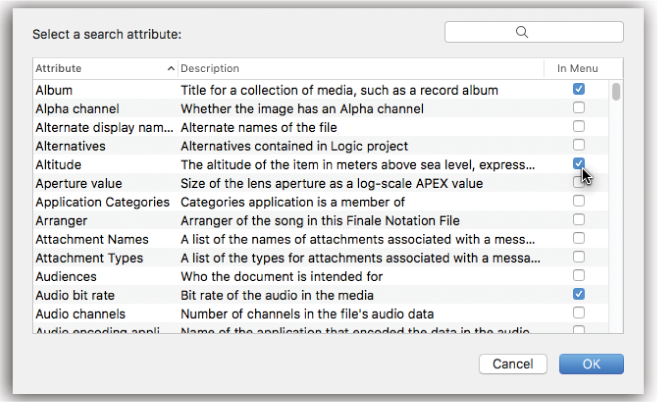
Figure 4-9. Here’s the master list of search criteria. Turn on the In Menu checkboxes of the ones you’ll want to reuse often. Once you’ve added some of these to the menu, you’ll get an appropriate set of “find what?” controls (“Greater than” and “Less than” pop-up menus, for example).
You may think Spotlight is offering you a staggering array of file-type criteria. In fact, though, big bunches of information categories (technically called metadata) are all hooks for a relatively small number of document types. For example:
Digital photos and other graphics files account for the metadata types alpha channel, aperture, color space, device make, device model, EXIF version, exposure mode, exposure program, exposure time, flash, f-number, focal length, ISO speed, max aperture, metering mode, orientation, pixel height, pixel width, red eye, resolution height, resolution width, and white balance.
Digital music files have searchable metadata categories like album, audio bit rate, bits per sample, channel count, composer, duration, General MIDI sequence, key signature, lyricist, musical genre, recording date, sample rate, tempo, time signature, track number, and year recorded. There’s even a special set of parameters for GarageBand and Soundtrack documents, including instrument category, instrument name, loop descriptors, loop file type, loop original key, and loop scale type.
Microsoft Office documents can contain info bits like authors, contributors, fonts, languages, pages, publishers, and contact information (name, phone number, and so on).
This massive list also harbors a few criteria you may use more often, like File Size, File Label, and File Invisible (which lets you see all the invisible files on your hard drive).
Now, you could argue that in the time it takes you to set up a search for such a specific kind of data, you could have just rooted through your files and found what you wanted manually. But, hey—you never know. Someday, you may remember nothing about a photo you’re looking for except that you used the flash and an f-stop of 1.8.
Tip
Don’t miss the search box in this dialog box. It makes it super-easy to pluck one useful criterion needle—File Size, say—out of the haystack. Also don’t forget about the In Menu checkbox in the right column. It lets you add one of these criteria to the main pop-up menu, so you don’t have to go burrowing into Other again the next time.
What to Do with Search Results
The results window is a regular old Finder window, with all the familiar views and controls (Figure 4-10).
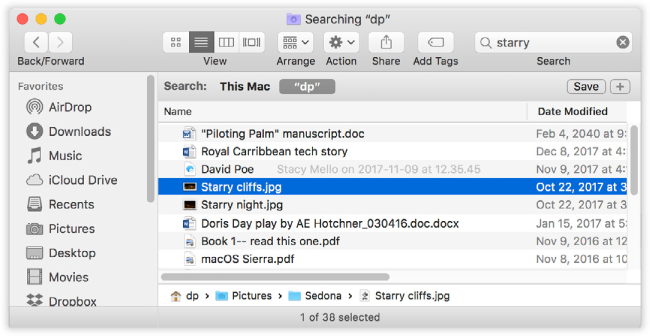
Figure 4-10. Click a result to see where it sits (shown at bottom). If the window is too narrow to reveal the full folder path, then run your cursor over the folders without clicking. As your mouse moves, the Mac reveals each folder’s name. (You can drag icons into these folders, too.)
You can work with anything in the results window exactly as though it were in a regular Finder window: Drag something to the Trash, rename something, press the space bar for a Quick Look at it, drag something to the desktop to move it there, drag something onto a Dock icon to open it with a certain program, Option-![]() -drag it to the desktop to create an alias, and so on.
-drag it to the desktop to create an alias, and so on.
You can move up or down the list by pressing the arrow keys, scroll a “page” at a time with the Page Up and Page Down keys, and so on. You can also highlight multiple icons simultaneously, the same way you would in a Finder list view: Highlight all of them by choosing Edit→Select All, highlight individual items by ![]() -clicking them, drag diagonally to enclose a cluster of found items, and so on.
-clicking them, drag diagonally to enclose a cluster of found items, and so on.
Or you can proceed in any of these ways:
Change the view (list, column, and so on) by clicking one of the View icons or choosing from the View menu (see Chapter 2). Actually, Cover Flow is a great view for search results; since this list is culled from folders all over the computer, you otherwise have very little sense of context as you examine the file names.
Sort the results by clicking the column headings (in list and Cover Flow views).
Arrange the results by using the Arrange pop-up menu button (
 ). That way, you group the results as described in “Use as Defaults”. It can be especially useful to clump them by Kind, so that similar file types are clustered together (Documents, Images, Messages, and so on), or to sort by Last Opened, so that the list is chronological.
). That way, you group the results as described in “Use as Defaults”. It can be especially useful to clump them by Kind, so that similar file types are clustered together (Documents, Images, Messages, and so on), or to sort by Last Opened, so that the list is chronological.Change the view options. Press
 -J (or choose View→Show View Options) to open the View Options panel for the results window. Here you can add a couple of additional columns (Date Modified, Date Created); change the icon size or text size; or turn on the “always” checkbox at the top, so that future results windows will have the look you’ve set up here.
-J (or choose View→Show View Options) to open the View Options panel for the results window. Here you can add a couple of additional columns (Date Modified, Date Created); change the icon size or text size; or turn on the “always” checkbox at the top, so that future results windows will have the look you’ve set up here.Get more information about a result by selecting it and then choosing File→Get Info (
 -I). The normal Get Info window appears, complete with date, size, and location information.
-I). The normal Get Info window appears, complete with date, size, and location information.Find out where it is. It’s nice to see all the search results in one list, but you’re not actually seeing them in their native habitats: the Finder folder windows where they physically reside.
If you click once on an icon in the results, the bottom edge of the window becomes a folder map that shows you where that item is.
For example, in Figure 4-10, the notation in the Path strip means: “The ‘Starry cliffs’ icon you found is in the Sedona folder, which is in the Pictures folder, which is in dp’s Home folder.”
To get your hands on the actual icon, choose File→Show in Enclosing Folder (
 -R). MacOS highlights the icon in question, sitting there in its window wherever it happens to be on your hard drive.
-R). MacOS highlights the icon in question, sitting there in its window wherever it happens to be on your hard drive.Open the file (or open one of the folders it’s in). If one of the found files is the one you were looking for, then double-click it to open it (or highlight it and press either
 -O or
-O or  -
- ). In many cases, you don’t know or care where the file was—you just want to get into it.
). In many cases, you don’t know or care where the file was—you just want to get into it.
Tip
You can also double-click to open any of the folders in the folder map at the bottom of the window. For example, in Figure 4-10, you could double-click the “Starry cliffs” file to open it, or the Sedona folder to open it, and so on.
Move or delete the file. You can drag an item directly out of the found-files list and into a different folder, window, or disk—or straight to the Dock or the Trash. If you click something else and then re-click the dragged item in the results list, the folder map at the bottom of the window updates itself to reflect the file’s new location.
Start over. If you’d like to repeat the search using a different search phrase, just edit the text in the search box. (Press
 -F to empty the search box and the Searching window.)
-F to empty the search box and the Searching window.)Give up. If none of these avenues suits your fancy, you can close the window as you would any other (
 -W).
-W).
Customizing Spotlight
You’ve just read about how Spotlight works fresh out of the box. But you can tailor its behavior, both for security reasons and to fit it to the kinds of work you do.
Here are two ways to open the Spotlight preferences center:
Use Spotlight itself. Hit
 -space bar, type spotl, and press Return.
-space bar, type spotl, and press Return.Choose
 →System Preferences. Click Spotlight.
→System Preferences. Click Spotlight.
In any case, you wind up face to face with the dialog box shown in Figure 4-11.
You can tweak Spotlight in two ways here, both very useful:
Turn off categories. The list of checkboxes identifies what Spotlight tracks. If you find that Spotlight uses up valuable menu space listing, say, web bookmarks or fonts—stuff you don’t need to find very often—then turn off their checkboxes. Now the Spotlight menu’s limited precious slots are allotted to icon types you care more about.
This trick can be especially useful if you don’t use Spotlight’s Internet-searching features. “I’m perfectly capable of looking up movies online,” you might say. “I don’t need to clutter my Spotlight results list with movie names.” Fine—turn off Movies.
Change the keystroke. Ordinarily, pressing
 -space bar highlights Spotlight in your menu bar, and Option-
-space bar highlights Spotlight in your menu bar, and Option- -space bar opens the Searching window. If these keystrokes clash with some other key assignment in your software, though, you can reassign them to almost any other keystroke you like.
-space bar opens the Searching window. If these keystrokes clash with some other key assignment in your software, though, you can reassign them to almost any other keystroke you like.To do that, click Keyboard Shortcuts; you jump directly to the System Preferences→Keyboard→Shortcuts tab. Here you can specify a new keystroke, as described in “Redefining a Keystroke”.
Apple assumes no responsibility for your choosing a keystroke that messes up some other function on your Mac.
 -S, for example, would not be a good choice.
-S, for example, would not be a good choice.On the other hand, if you choose a Spotlight keystroke that macOS uses for some other function, a little yellow alert icon appears in the Spotlight pane. This icon is actually a button; clicking it brings you to the Keyboard pane, where you can see exactly which keystroke is in dispute and change it.
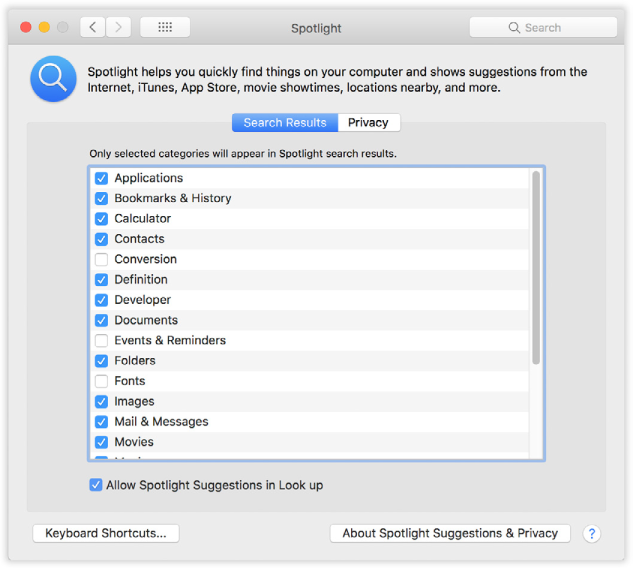
Figure 4-11. Here’s where you can specify what categories of icons you want Spotlight to search, and what keystroke you want to use for highlighting the Spotlight search box.
(You can no longer drag these items up and down to control how the categories appear in the Spotlight results, as you could in some recent versions.)
Privacy Settings
You can hide certain folders from Spotlight searches. Maybe you have privacy concerns—for example, you don’t want your spouse Spotlighting your stuff while you’re away from your desk. Maybe you just want to create more focused Spotlight searches, removing a lot of old, extraneous junk from its database.
Either way, the steps are simple. Open the Spotlight panel of System Preferences, as described previously. Click the Privacy tab. Figure 4-12 explains the remaining steps.
Tip
When you mark a disk or folder as non-searchable, Spotlight actually deletes its entire index (its invisible card-catalog filing system) from that disk. If Spotlight ever seems to be acting wackily, you can use this function to make it rebuild its own index file on the problem disk. Just drag the disk into the Privacy list and then remove it again. Spotlight deletes, and then rebuilds, the index for that disk.
(Don’t forget the part about “remove it again,” though. If you add a disk to the Privacy list, Spotlight is no longer able to find anything on it, even if you can see it right in front of you.)
Once you’ve built up the list of private disks and folders, close System Preferences. Spotlight now pretends the private items don’t even exist.
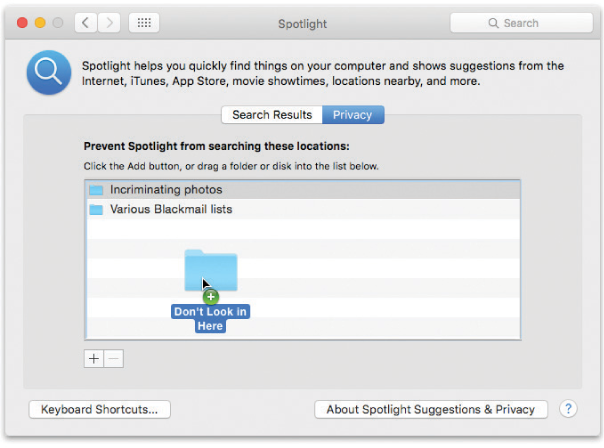
Figure 4-12. You can add disks, partitions, or folders to the list of non-searchable items by dragging them into this window. Or, if the private items aren’t visible at the moment, click +, navigate to your hard drive, select the item, and then click Choose. To remove something from this list, click it and then press the Delete key or click the — button.
Smart Folders
A smart folder is a self-updating folder. It always contains exactly the items that match criteria you’ve specified in advance. (Smart folders are a lot like smart albums in iTunes, smart mailboxes in Mail, and so on.)
The key to creating one, as it turns out, is the little Save button in the upper-right corner of the Searching window when you’ve built a search request.
Here’s a common example. You choose File→Find. You set up the pop-up menus to say “last opened date” and “this week.” You click Save. You name the smart folder something like Current Crises, and you turn on Add to Sidebar (Figure 4-13).
Tip
Behind the scenes, smart folders are special files in your Home→Library→Saved Searches folder.
From now on, whenever you click that smart folder, it reveals all the files you’ve worked on in the past week or so. These items’ real locations may be all over the map, scattered around your Mac and your network. But through the magic of the smart folder, they appear as though they’re all in one neat folder.
Tip
If you decide your original search criteria need a little fine-tuning, click the smart folder. From the ![]() menu, choose Show Search Criteria. You’re back on the original setting-up-the-search window. Use the pop-up menus and other controls to tweak your search setup, and then click the Save button once again.
menu, choose Show Search Criteria. You’re back on the original setting-up-the-search window. Use the pop-up menus and other controls to tweak your search setup, and then click the Save button once again.
To delete a smart folder, just drag its icon out of the Sidebar. (Or if it’s anywhere else, like on your desktop, then drag it to the Trash like any other folder.)
